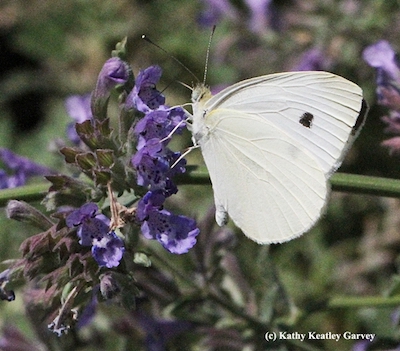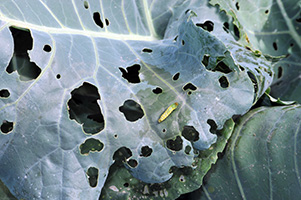Worm Your Way Out of Cabbage and Broccoli
By Ray Novitske, Fairfax Master Gardener
From Europe we import many fine wines, cheeses, chocolates, olive oil and truffles. Once in the later half of the 1800s, eastern Canada also accidentally imported a pest that spread throughout North America in later decades — the imported cabbage worm (Pieris rapae). Also known as the white cabbage butterfly, it is the caterpillar or larva phase of the insect that causes damage to cabbage… or broccoli, Brussels sprouts, Chinese cabbage, cauliflower, kale or collards.

White cabbage butterfly
Adults appear in mid-spring and begin by laying solitary eggs on the underside of cabbage leaves and other plants in the brassica or mustard family. They hatch in about a week. The caterpillars are green with one lighter stripe lengthwise down their backs. As soon as the eggs hatch, the little beasties begin munching their way through the leaves, leaving increasingly larger and larger holes as they mature. They prefer to hang out on the bottom of the leaves and are often concealed next to the veins or midrib on the underside of leaves.
Imported cabbage worms will pupate on any nearby materials or debris. After about a week, the butterfly emerges to fly from flower to flower and feed on nectar like other butterflies. There can be several generations in a season, which is why we always see them from spring, through the summer, until September. The pupae set in the fall will survive the winter with the butterflies emerging in the spring.

Two cabbage worms hiding on leaf underside
The caterpillars can be parasitized or preyed upon by biological enemies. There are parasitic wasps and tachinid flies that lay their eggs on the cabbage worms. A few lethal insect pathogens and viruses are known to attack both the worms’ eggs and larvae.
Bt, Bacillus thuringiensis is a bacteria that lives in soil and produces crystal-like toxic proteins that kill mostly caterpillars when eaten. It can be purchased in stores and comes in powder or liquid form. Its toxin paralyzes the insect’s digestive tract which causes it to stop feeding. Death occurs in one to four days. It does not harm mature insects or natural enemies, is not toxic to pets or animals and does not kill parasitoids.

Leaf damage
I always see the imported cabbage worm on the cabbage (I love fresh cole slaw) and broccoli I grow. It is a very common pest of the cabbage family of plants, but it can be controlled in the home garden without the use of pesticides toxic to beneficial insects, animals, or us.
References
The Pest Caterpillars of Cole Crops in Virginia, Virginia Cooperative Extension
Cabbage Insects, University of Kentucky College of Agriculture Food and Environment
Cole Crop “Worms”, University of Connecticut Integrated Pest Management
Imported Cabbageworm, John L. Capinera, University of Florida Institute of Food and Agricultural Sciences
Caterpillar Pests of the Cabbage Family, Arthur L. Antonelli, Washington State University Extension
Using B.t. to Manage Caterpillars on Cole Crops, Celeste Welty, Ohio State University